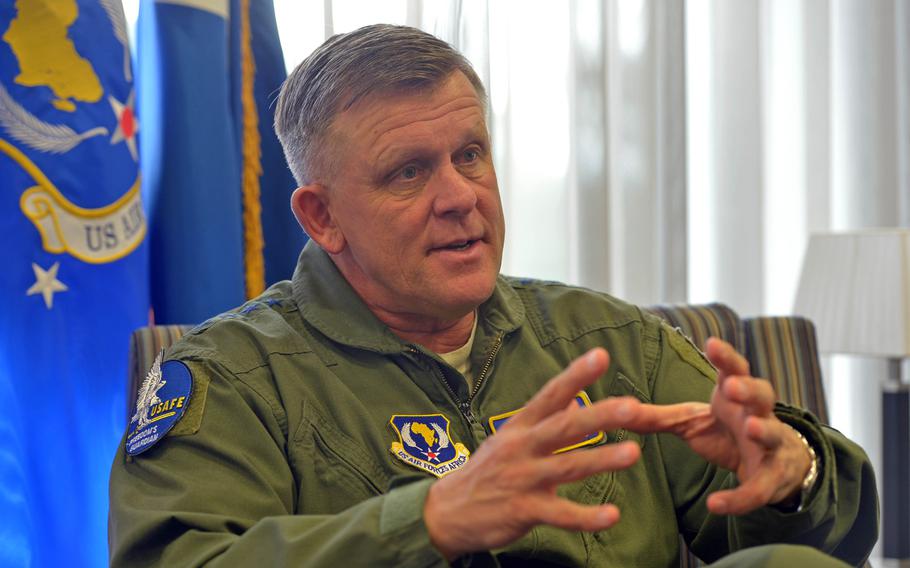
Gen. Frank Gorenc, commander of U.S. Air Forces in Europe and U.S. Air Forces Africa, talks to Stars and Stripes at USAFE headquarters on Ramstein Air Base, Germany, Thursday June 30, 2016. (Michael Abrams/Stars and Stripes)
RAMSTEIN AIR BASE, Germany — Despite continuing tensions with Russia, the top U.S. Air Force general here says there are no plans to base the F-22 Raptor — America’s most sophisticated warplane — in Europe.
Gen. Frank Gorenc, outgoing commander of U.S. Air Forces in Europe-Air Forces Africa, also predicted that the military would have to pay greater attention in the future to instability in Africa and Islamic radicalism there.
“The Mediterranean Sea doesn’t separate Africa’s problems from Europe’s problems anymore,” he said.
Gorenc, 58, has commanded USAFE-AFAFRICA and Allied Air Command — the air component of NATO — since August 2013. He is due to retire next month, and President Barack Obama has nominated Lt. Gen. Tod D. Wolters as his replacement.
Gorenc oversaw Air Forces in Europe during a critical time that included Russia’s annexation of Ukraine’s Crimean Peninsula. That move and Moscow’s involvement in the secessionist war in eastern Ukraine triggered heightened military tensions in eastern Europe and led to additional deployments of Air Force assets to Europe, including the first deployments of F-22s to the Continent.
Last year’s announcement that F-35 Lightning II joint strike fighter jets will be permanently stationed at RAF Lakenheath in Britain in 2020, led to speculation that they could eventually be joined by F-22s.
But in an interview Thursday with Stars and Stripes, Gorenc said there would be no permanent move of F-22s to Europe.
“We have announced a permanent presence of F-35s that will be going to Lakenheath (and) we’ve begun the process of preparing the base,” he said.
“What we have been doing with the F-22 is bringing it to Europe because of the capability that it provides … in A2/AD environments.”
He was referring to the dense “anti-access/area denial” network of air defenses that Russia has installed in Crimea and elsewhere.
The two recent deployments of Raptors to Europe were meant to familiarize their pilots with the European arena and ensure that the infrastructure available in Europe could support the sophisticated Fifth Generation warplanes, Gorenc said.
Turning to Africa, he warned that the mission on that continent had expanded significantly in the past three years.
“What I have seen is the requirements with respect to Africa are coming to the forefront,” he said. “The instability and insecurity caused by large masses of ungoverned space and weak governments with failing institutions, create areas that are particularly vulnerable to Islamic extremism.”
Those tendencies, along with uncontrolled refugee flows, has created a situation where some of Africa’s problems are becoming European problems, he said.
“We’ve been paying attention to that, particularly in the mobility and the ISR (intelligence, surveillance and reconnaissance) areas,” Gorenc said.
During Gorenc’s tenure, there has been a surge of surveillance activity on the continent, stretching from the volatile eastern Horn of Africa where insurgents pose a threat in Somalia to western Africa where drones are used to track groups such as Boko Haram in Nigeria. Lethal airstrikes, while rare, have also been carried out in Somalia and Libya, where the Islamic State group has gained a foothold.
Gorenc rose to the highest level within the Air Force after immigrating from what was then Yugoslavia.
He and his older brother, retired Air Force Maj. Gen. Stanley Gorenc, were born in the 1950s in Ljubljana, capital of now-independent Slovenia. The brothers immigrated with their parents to the United States in the 1960s when they were 8 and 4.
Gorenc said he was grateful for the privilege of having overseen Air Force operations in Europe and Africa and of NATO’s air component.
“I want to just say to all of the airmen that are out there, to all their families, and to all our partners ... what fantastic support I felt along the way,” he said. “Together we have accomplished a lot.”
Stars and Stripes reporter John Vandiver contributed to this report.